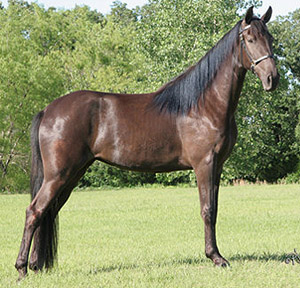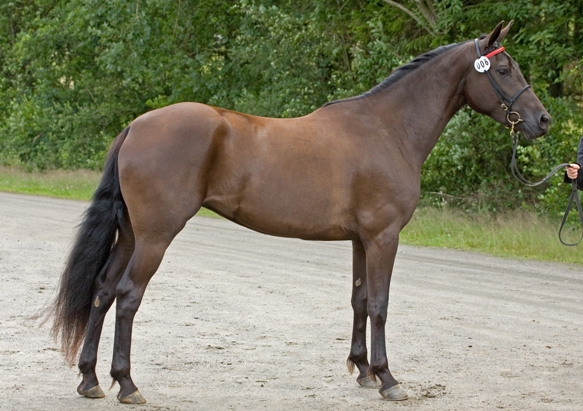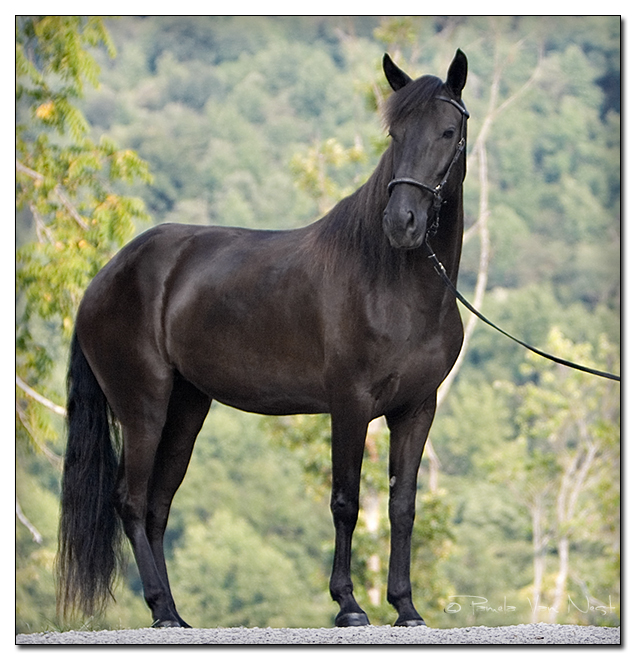Miss Woodford wrote:Ridan_Remembered wrote:Please don't misunderstand what I'm about to ask, as I do not mean in any way to cast doubt on this colt's breeding, but I wonder if some of the unusual coloring we see from time to time in Thoroughbreds might come from less-than-ethical breeders crossing a TB to a non-TB, then registering the foal as a TB. If this happened, it would have been more likely back in the pre-DNA days. Are Thoroughbreds DNA tested for registration these days?
Oh, there are certainly conspiracy theories about the parentage of Milkie and Glitter Please, the only two sources of all dilute TBs. None of their ancestors were known to be dilute in color, and with no photos or DNA testing we have no way of knowing if there were in fact the "secret buckskins" that color breeders claim somehow carried down the gene for hundreds of years without being detected. The rumors are that Milkie was actually a QH cross (probably 1/4 or 1/8) while GP was a Saddlebred cross; both of their female families are fairly obscure. I'll let you make up your own mind about that...
Another issue is that several color-bred horses (notably the stallion Goldmaker) have had their papers pulled by the JC after it was discovered that they were conceived via AI, so their offspring cannot be registered as full TB.
You piqued my curiosity so I decided to go look on pedigreequery.
Glitter Please... you have to go back to the 4th dam to find a mare that was unraced (1929) and she is by and out of two British-bred horses. His first dam is by a son of an Epsom Derby winner and out of an old school war horse with 70 starts (8 wins) who is herself sired by Supremus who most notably sired Alcibiades.
GP's second dam is by Drawby which is where in GP's pedigree is the suspected provenance of the dilute as smokey black (which would not really be visible as a single dilute, and would appear as dark brown). This horse was raced with 18 wins out of 56 starts. He is out of a Phipps mare. If you look at his sire, he's a chestnut so right away I suppose I'd rule out the dilute here but even so just in case he somehow was a dark palomino, turns out this is a stud bred by HP Whitney. He's a grandson of broomstick and his damsire is Peter Pan. Drawby's dam, Drawbridge (the aforementioned Phipps mare) is registered as bay and by Sir Gallahad.
The most interesting find in his pedigree is Drawbridge's dam, Traverse who while bred in the UK was by a US-born stallion (but whose pedigree is all UK and France) and out of a US-bred mare (whose damline is all US-bred mares until Castagnette (GB) born 1872) and the English Stud Book apparently would not register her because she was 'tainted' with Lexington blood, so Mr Whitney imported her (she was born in 1915 two years after the Jersey act (1913) --- Lexington's dominance in the pedigrees of American-bred Thoroughbreds, and the fact that the British Thoroughbred breeders considered him not a purebred, was a large factor in the so-called Jersey Act of 1913, in which the British Jockey Club limited the registration of horses not traced completely to horses in the General Stud Book. Lexington features as the grandsire of her 3rd dam. Traverse was apparently unraced and was the Dam of two stakes winners, she is the second dam of 13 more including 1954 Kentucky Broodmare of the Year Traffic Court and is the third dam of the high-class half brothers Hasty Road and Traffic Judge.
Honestly digging through is pedigree I have a hard time seeing where someone would've snuck in a saddlebred. I wouldn't say his female family is prominent but it is hardly obscure, both in the names featured as breeders and sires and in terms of horses actually racing. If you were using a mare you'd have to have found a stallion owner willing to fudge the papers or willing to breed a non-TB mare, in the latter case you'd also need to have been the owner of the TB mare whose papers you were 'stealing' to the same stallion and be willing to cut her foal as a loss from that year. (Which wouldn't be profitable and why would you waste a valuable season of a TB mare's limited years of production?) same if you were using a saddlebred stallion, you'd either need to also own a tb stallion whose papers you could switch out to, pay off someone to report their tb stallion as having bred their mare, or switch out an entire foal and be willing to 'lose' one.
Milkie's female side is murkier, a lot more unraced mares... But Milkie himself was described as a light chestnut initially while looking at old ads and clippings of him from the 60s and 70s. If he could be registered as a chestnut why not other palominos before him? And I can definitely see how smokey blacks could pass as dark brown, heck I could even see how sooty buckskins could pass as dark bay or brown. As an aside the only ancestor I could find in common for these two stallions is Sir Gallahad. I'm too tired and a bit too lazy to see how he (or if either Milkie and Glitter Please) traces back to the Byerley Turk, but if the Byerley Turk was in fact an Akhal-Téké as is suspected by some historians rather than an Arabian as previously thought, it's not a stretch that he could've carried a dilute gene at the very foundation of the Thoroughbred breed.
After all this reading I'm not certain I buy the conspiracy theories.


















